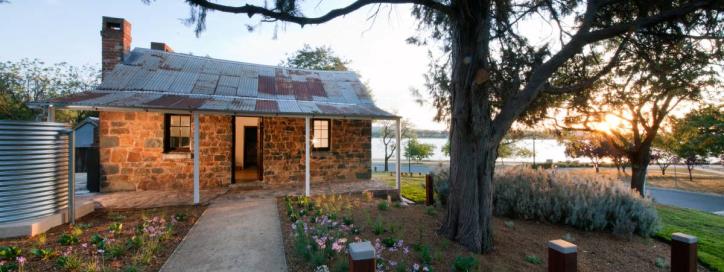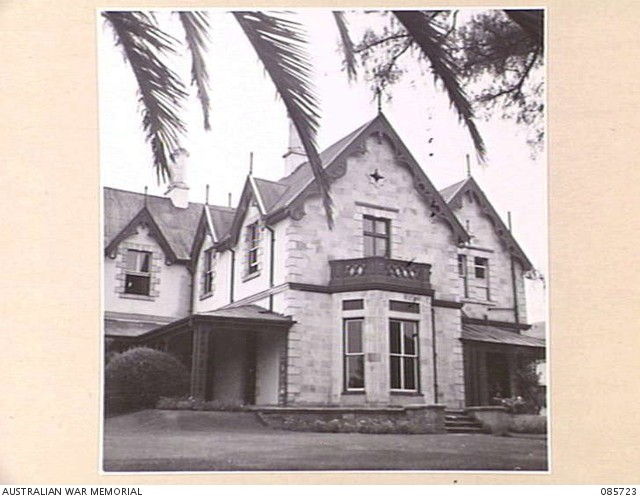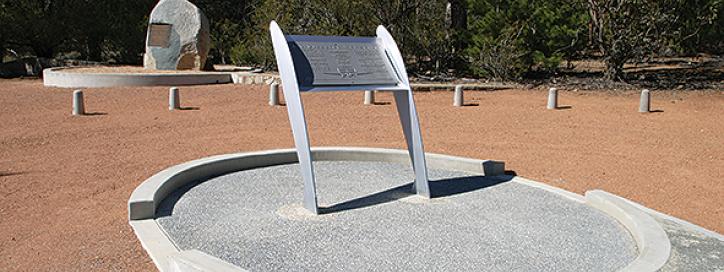Most Haunted Places in Canberra: 8 Ghostly Hotspots
Canberra may be known for its politics and parks, but I’ve learned it has a spooky side too.
From century-old cottages to grand old houses, the city is dotted with tales of restless spirits.
Whether you’re a sceptic or a believer, a night tour through these historic sites can send a chill down your spine.
Let’s take a lantern-lit ramble through some of Canberra’s most haunted spots – with a dash of history, ghost stories and practical tips for curious visitors.

1. National Film and Sound Archive (Acton)
Located on McCoy Circuit in Acton, the National Film and Sound Archive (NFSA) occupies a grand old stone building with a grisly past.
Opened in the 1930s as the Institute of Anatomy, it once housed human and animal specimens – even parts of Phar Lap and Ned Kelly’s skull were on display.
The place has “only been the NFSA since the early 1980s”, but for decades before that, it was filled with skeletons and body parts. It’s no surprise that many visitors and staff now regard it as “Canberra’s most haunted building”.
Locals report unexplained poltergeist activity in the dimly lit corridors.
Tim the Yowie Man – the city’s well‑known cryptonaturalist – recounts trolleys and display cases moving on their own, and glass jars shattering or sliding off shelves for no apparent reason.
One chilling account describes film projectors’ reels magically ejecting their tapes despite being locked in place.
A pair of ghost-hunters even set up EMF meters and were horrified when all the batteries in their six devices drained from full to flat at the same time overnight.
As one museum staffer put it, you don’t have to want to believe in ghosts here – “you don’t need to be a true believer… to have an experience”.
If you’re game, the NFSA actually runs special night tours.
The “Ghost Tour with Tim the Yowie Man” invites brave guests into the basement and theatre after dark to hear those strange stories firsthand.
Armed with EMF readers and ghost-hunting lore, your guide will lead you into the shuttered museum, where the air feels thick with history.
Tip: the NFSA is open daily 10 am–4 pm for normal visits; the ghostly side is reserved for booked evening events.
Either way, whether you spend a penny on admission or not, even passing the NFSA on a quiet night leaves many Canberrans feeling like someone – or something – is watching.
2. Old Parliament House (Museum of Australian Democracy, Parkes)

Old Parliament House (now the Museum of Australian Democracy) on King George Terrace is not just the cradle of Canberra’s democracy (it was home to the federal government from 1927 to 1988) – it’s also one of the city’s eeriest buildings.
By day, it’s a museum, but after dark, many swear it comes alive with ghostly activity. When I joined an “Old Haunted House” tour, the volunteer guide Lee noted that staff and visitors have long sensed something uncanny in the halls.
People often report a sudden vibe – a prickling on the skin or hair standing up – as if a presence is nearby. Lee herself, a confessed sceptic, admits there have been too many strange encounters to dismiss.
One recurring phantom is a tradesman in white overalls carrying an open paint tin. Night staff have literally walked after this ghostly painter – only to see him vanish through a locked door.
Another reported sighting: a gentleman in a suit in the Senate Courtyard, who simply disappears when approached.
Perhaps most famous is the tale of a politician’s spirit in the House of Representatives chamber: during our torch-led tour, participants gathered around the old members’ bench where a long-dead MP once collapsed.
The EMF meter danced wildly there, sparking excitement and goosebumps.
In the former Prime Minister’s office, guides claim you can sometimes smell cigar smoke – a throwback to Bob Hawke’s final Canberra days – and again see spikes on the detector. (Lee joked that if you meet one of these bygone MPs, it’s best to say “Carry on” and leave them be simply.)
Old Parliament House doesn’t encourage casual ghost-hunting, but it has embraced the legend.
The MoAD museum even hosts a guided after-hours “Old Haunted House Experience”. For a fee (about $69), small groups explore the darkened rooms by torchlight, armed with “ghost-hunting tools” and stories of past tragedies.
It’s a theatrical mix of history and horror – perfect for thrill-seekers. Otherwise, by day, the museum is fully open and accessible (including wheelchair ramps) to anyone interested in its historic halls.
Keep an ear out on a quiet afternoon – you may just catch a whisper or two of the building’s long political past… and its lingering secrets.
3. Blundells Cottage (Kings Park)

Perched on the edge of Lake Burley Griffin near Kings Park, Blundells Cottage is a tiny heritage stone cottage straight out of pioneer times.
Built around the 1860s, it was originally the farmhouse for Duntroon estate workers and later became the home of the Blundell family for decades.
Today it’s managed by the National Capital Authority as a museum (open weekends 10 am–2 pm, free entry). In stark contrast to the shiny city nearby, Blundells looks like a little colonial relic – exactly the kind of place a ghost story might grow out of.
And indeed, the legend goes that “Florrie” Blundell, a teenage girl, met a terrible end here. In 1892, young Flora (Florrie) Blundell was ironing in the cottage when her dress caught alight.
She survived the fire, but later died from her burns.
Since then, visitors say her spirit lingers in subtle ways. Many people report smelling burning flesh or smoke inside the cottage on still days – an eerie reminder of Florrie’s fiery death.
Rumour even claims the apparition likes necklaces: a psychic once suggested that Florrie died wearing her favourite necklace.
Many visitors now wear a necklace intentionally, hoping to catch her attention.
Several witnesses have described seeing the young girl herself, pale and almost dancing, among the garden beds late at night.
Staff and ghost‑hunting locals keep a semi‑official log of encounters at Blundells.
Tim the Yowie Man, who frequently leads ghost tours there, notes that most eerie reports come from teenage girls wearing pendants.
One group in 2010 claimed a black shadow rose from a chair and drifted across a room, startling them enough that they bolted.
These stories give the little cottage a reputation as a paranormal hotspot. In practice, visiting Blundells is straightforward: it’s on Wendouree Drive (Kings Park, just below Mt Pleasant) and the ground floor rooms are open for browsing on weekends. It’s a short free stop on a trip around Lake Burley Griffin.
(No official after‑dark tours are run here, but curious ghost-chasers sometimes stake out the yard with cameras and EMF meters in hopes of sensing Florrie’s presence.)
Whether or not you buy into ghost myths, Blundells is charming and historically rich – and on a spooky night, you might swear the air briefly smells of singed fabric.
Just watch your step: the cottage is 150+ years old and built low to the ground, so tread carefully as you peek through its chilly stone rooms.
4. Duntroon House (Royal Military College, Campbell)

Hidden within the grounds of the Royal Military College at Duntroon (near Mount Pleasant in Campbell) stands Duntroon House, Canberra’s oldest European-style residence (circa 1833).
It was once the home of the Campbell family (for whom the suburb is named).
Historians note that Sophie Susanna Campbell – the family’s eldest daughter – died here in 1885 in mysterious circumstances.
Rumour has it that she fell (or was pushed) from an upper bedroom window.
Today, the old mansion is as grand and solemn as ever, but with a chilling undertone.
Many officers and staff at the college claim to have experienced Sophie’s ghost.
Furniture in her old bedroom has been known to shift on its own, and a neatly made bed might suddenly be unmade despite nobody having slept there.
Even the gardeners sense something: people strolling near the rose garden below Sophie’s old window say they sometimes glimpse a pale figure “spurring” or walking on the grass.
It’s said that cadets on overnight guard duty at Duntroon often draw straws to decide who will sleep in the “Sophie room” – the idea being nobody wants that assignment!
Duntroon House isn’t generally open to the public (it’s on active military property), but the exterior can be admired from the nearby driveway.
The college sometimes hosts special open days when visitors can enter and see the historic rooms (and maybe feel Sophie’s presence in the air).
For most tourists, the best you can do is a respectful stroll around the well-kept gardens at dusk.
Even with the grand old building to one side and the lawns lit only by lamplight, the atmosphere can feel… charged. Locals whisper that Sophie was a spirited soul in life, and perhaps she hasn’t left.
5. Hotel Kurrajong (Barton)
Hotel Kurrajong, a heritage-listed hotel in Barton (near Old Parliament House), is famous both for its history of hosting politicians and for its paranormal lore.
Built in 1926, the Kurrajong was intended as comfortable lodging for Canberra’s early officials (designed by Commonwealth architect John Smith Murdoch).
Its most famous guest was Prime Minister Ben Chifley, who habitually stayed there rather than the Prime Minister’s Lodge.
Tragically, in June 1951, Chifley suffered a fatal heart attack in or around his room at the Kurrajong. He never saw his family again.
Since Chifley’s death, tales of his spectre have become part of the hotel’s identity. Guests who have booked the very room where Chifley died (room 214) often report lights flickering or a presence in the corner late at night.
Even on the lawn below that room, people have claimed to see “a grey-suited man” at the window, pointing emphatically toward Parliament House.
Many believe it’s Chifley himself, still championing democracy. (Indeed, one local joke is that if you see a dignified old gentleman on the balconies, you shouldn’t bother him – after all, he’s probably just on parliamentary business.)
Staying at the Kurrajong today is a treat: the hotel is fully operational with modern amenities.
History buffs can dine at its classic restaurant, have a drink in the wood-panelled bar, or even book in if you dare – especially on Budget Tourism nights when inexplicably cheap deals sometimes mean Chifley’s ghost might pop in to say hello! There are no official ghost tours, but the staff are used to curious questions.
If you’re in the mood for spooky ambience, just ask the bartender (or a late-shift porter) about the Chifley room.
Even if you don’t see or hear anything, the elegant 1920s lounge and lush garden make you feel as if you’ve stepped back into history – and perhaps touched by it.
6. National Museum of Australia (Acton)
The National Museum of Australia in Acton sits on a site with a haunted past. The museum building opened in 2001, but before that, the spot was home to Canberra Hospital (up until the 1980s).
Nurses’ quarters, operating theatres and a big hospital kitchen once filled this ground. Many inside and around the museum now believe those memories linger.
Cryptonaturalist J.G. Montgomery recounts an incident where staff saw an “old woman… in a bathtub where no tub exists” – presumed to be the ghost of a matron from the old hospital era.
Others describe fleeting visions of patients or nurses wandering through the marble-floored foyers late at night.
More playfully, a common report is the random scent of hot cross buns drifting through the museum’s air conditioning.
It turns out the old hospital kitchen once baked large batches of buns on Fridays, so some think the olfactory flashback is a ghostly remnant of that routine.
Occasionally, movable display boards are said to spin by themselves in the galleries after hours.
No matter how you slice it, the museum has a reputation for the unexplained – though nothing here feels overtly menacing.
After all, the museum is brightly lit, features new exhibits, and attracts frequent visitors by day. Most paranormal occurrences happen unnoticed at night or are chalked up to drafts and sensor errors by sceptics.
In terms of visiting, the National Museum is easily accessible (open daily from 9:30 am to 5 pm, with free entry), located on the Acton Peninsula at the foot of Anzac Parade.
There are no formal ghost tours available for this site; however, the museum occasionally features ghost stories during its Halloween events.
You can tour the silent hallways and imagine the old Canberra Hospital patients moving along them. If your nose catches a whiff of cinnamon or baking at an odd hour, consider it a salute from history.
7. Lanyon Homestead (Tharwa)

A short drive south of Canberra brings you to Lanyon Homestead, a vast colonial-era farmstead in the Tharwa valley (now managed by the National Trust).
Established in the 1830s, Lanyon was a working sheep and horse station with generations of settlers, convicts and labourers. Its brick woolshed and stone kitchen are some of the oldest structures in the region.
Given its age and rough pioneering history (including drownings in the nearby river), it’s not surprising that ghost stories swirl here.
One favourite tale involves the old kitchen fireplace.
Visitors claim to occasionally glimpse a solitary figure – a frontier-era stockman or farm labourer – standing at the hearth with hands outstretched toward the warmth of the fire.
The legend says he’s a restless worker who never got to finish a day’s work.
Staff and guests at the homestead have reported seeing this man disappear into thin air when approached.
Others hear footsteps or low murmurs in the twilight hours around the woolshed, as though the past is echoing through the corrugated sheds.
Lanyon is open to the public (typically Wednesday–Sunday, 10 am–4 pm) for tours and a popular weekend café.
For the brave, there’s even a ghost-themed event called the “Legends of Lanyon” tour, where you explore the homestead after dark and learn these spooky stories by lantern light.
All told, Lanyon’s combination of historic authenticity and a few forlorn spectres makes for atmospheric afternoon or evening visits.
It’s a lovely drive to Lanyon, and the chance to wander its overgrown gardens and dimly lit rooms is a chance to step back into the early days of the territory – perhaps with a friendly ghost for company.
8. Air Disaster Memorial (Mount Ainslie)

Finally, no haunted tour of Canberra would be complete without a tribute to the Air Disaster Memorial on Mount Ainslie.
This modest roadside monument (near the summit lookout) marks a tragic moment: on 13 August 1940, a Royal Australian Air Force Hudson bomber crashed into the hill after takeoff, killing three federal ministers, the Chief of the General Staff and six others.
For decades, this windswept spot has been a magnet for ghost stories.
Drivers who venture up Ainslie late at night have for years reported their cars suddenly stalling on the cattle grid, as if the engines died on their own.
Lights will inexplicably dim or flicker. In the eerie silence, some hear distant, hushed voices or even see spectral forms.
One local writer notes tales of a phantom “ghostly nurse” who cared for crash victims, running to help motorists who pause near the crash site (though that particular legend is probably a mistaken twist on the real story).
In more sober accounts, people simply felt an overwhelming sadness or a mysterious presence where so many died.
The memorial itself is currently barricaded from road access (for safety), though you can hike up from Mt Ainslie Road.
No organised tour operates here regularly, but ghost enthusiasts sometimes run impromptu night walks.
Even casual visitors can approach the fenced site on foot to pay respects. (If you do, stay by the railings; this is not a good place to linger alone after dark.)
Many Canberrans consider the Air Disaster Memorial the spookiest spot in town.
As Tim the Yowie Man says, battery drains and ghostly fire-like silhouettes have earned it “a reputation as one of the most haunted spots in Canberra”.
The place has a solemn, chilly beauty – even on a sunny day, the winds whipping past seem to whisper the past.
For me, a quick sunset picnic near this monument is enough thrill; in the fading light, it’s easy to imagine shadowy figures among the gum trees.
Respect the site, tread carefully on the grass (the memorial ground is a burial site), and maybe say a quiet word for those long-gone souls. The breeze on Mount Ainslie carries their story.
Final Thoughts
Each of these spots mixes real history with tales from local lore.
Some believe every haunted tale; others chalk it up to imagination and the creaking of old buildings.
Either way, exploring Canberra’s haunted corners makes you see the city anew – after all, it is one of the few capitals where policemen chase ghosts instead of tourists.
Next Halloween (or any full moon), try visiting one of these places yourself.
The ghosts of Canberra’s past might just give you something to talk about over a cuppa later – if you’re willing to hear them.
